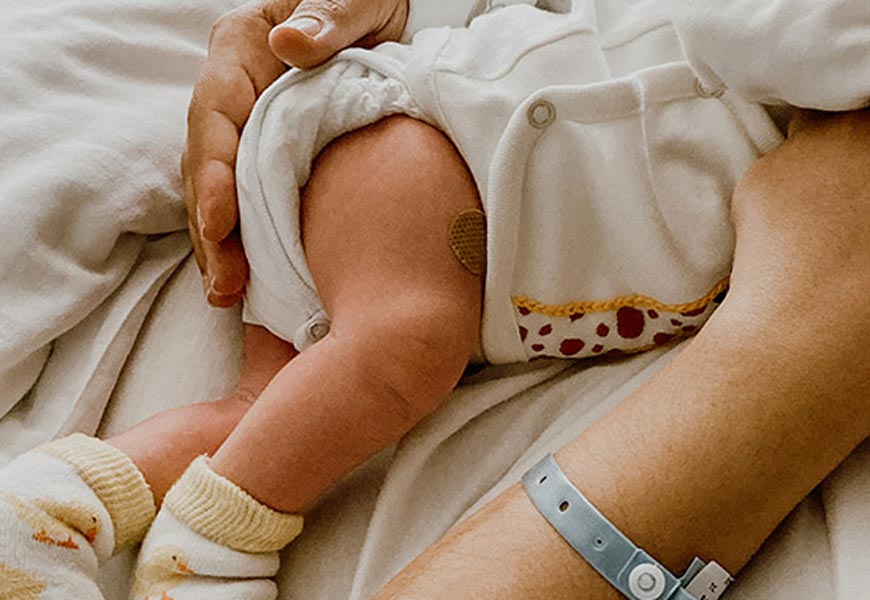

- Regular price
-
99,00 € - Regular price
-
167,80 € - Sale price
-
99,00 €


- Regular price
-
35,90 € - Regular price
-
- Sale price
-
35,90 €
- Giving birth without an epidural, the advantages
- Giving birth without an epidural: is it possible in all cases?
- What preparation for childbirth without an epidural?
Giving birth without an epidural, the advantages
But more and more women are dreaming of a less medicalized delivery, which would leave them free to move, without hindering them from an infusion. This is why childbirth in a birth center is increasingly popular with future mothers who want to welcome their baby in a more friendly and less strict environment than in a traditional maternity ward.
Supervised by a midwife, who generally followed them throughout their pregnancy and during preparation for birth, women who have opted for a physiological birth are placed in a cozy room with their partner. They are free to adopt the position of their choice, to hang from vines, to take a bath or to listen to music. All without an epidural, nor any possibility of obtaining one, since no doctor or anesthesiologist is present on the scene. However, in the event of complications, the pregnant woman will be automatically transferred to the nearest partner hospital where an epidural may be offered. For women who wish to attempt childbirth without an epidural, there are hospitals with physio childbirth rooms where it is possible to change your mind and request an epidural midway without having to be transferred to a different location.

Childbirth without an epidural has a number of advantages: you can get up, move, and therefore help the baby descend into the pelvis. “No peri” delivery is therefore often quicker. No anesthetic products to eliminate: just after birth, you are alert, you can move and your legs are not numb. Better recovery generally awaits you!
Finally, without an epidural, you feel each contraction intensely and some women feel like they are involved in their birth, as if they are reconnected to nature and their essence.
Giving birth without an epidural: is it possible in all cases?
The answer is no, and even if giving birth physiologically is important to you, you will still need to prepare to potentially give birth with an epidural. The 7th month visit to the maternity anesthesiologist is obligatory, whatever your birth plan. If the delivery is long, particularly difficult, or if your body has difficulty managing the pain, you may wish to reconsider your decision. And let's make it clear from the outset: each birth is different, each has its own pain tolerance threshold and there is no harm in finally opting for the epidural. The epidural can be applied almost until the last moment, unless the dilation of the cervix is complete and the birth is imminent, because it will not have time to act.
In some cases, vaginal delivery is not possible and cesarean section is necessary. The latter will then be scheduled (for example if the baby is too big to pass vaginally) or decided urgently if complications arise. In this case, anesthesia is mandatory, and depending on your case, you may be offered an epidural, spinal anesthesia or general anesthesia. The difference between epidural and spinal anesthesia ? Spinal anesthesia is a simpler and quicker procedure than its sister the epidural: a needle is inserted between two lumbar vertebrae up to the cerebrospinal fluid and the analgesic is injected. It takes effect in five minutes and lasts one and a half to two hours. The epidural works in 15 to 20 minutes. The anesthetist will prick the same place but stop at the epidural space. He inserts a catheter which will remain in place throughout the delivery. It allows the mother-to-be to reinject anesthetic product via a pump each time it is necessary. We often hear that with an epidural, the mother-to-be no longer feels the contractions and therefore has more difficulty pushing effectively. This is not entirely accurate because you are free to dose the anesthetic (within defined limits): you can therefore choose to feel the contractions more or less intensely by opting for low doses of product.
The doctor will ultimately resort to general anesthesia if this is unavoidable, for example in cases of fetal distress. In this case you have to act quickly to help the baby.
What preparation for childbirth without an epidural?
If you want the most natural birth possible, the best thing is to anticipate and prepare well. There are several pain management techniques, which you will need to learn and master to put them into practice on the day of birth. For example, working on breathing is essential to support contractions. Sophrology, relaxation, yoga or prenatal singing are all methods that will help you better tolerate pain. Sophrology also allows you to visualize childbirth in advance as something positive, so it will be easier to manage the big day without apprehension. Consider choosing childbirth preparation classes that focus on these techniques. The future father or your partner also has a role to play: massage, pressure on acupuncture points, hypnosis: the support of your other half is essential, and he or she should not hesitate to train to support and assist you as best as possible D-day.

Epidural or not, the decision is individual and up to you. It is also allowed to change your mind, in one direction or the other, during pregnancy or childbirth or from one pregnancy to another. If we all have our ideal birth in mind, we must also know how to consider several scenarios to be as well prepared as possible and live this moment to the fullest. We wish you a wonderful meeting with your baby !
(1) Source ARS













































